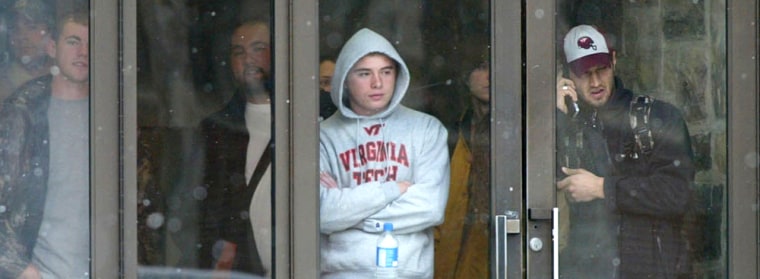To address the kinds of security concerns raised by the Virginia Tech shootings, colleges and universities are installing communication systems to alert thousands of students at a time about potential threats.
They’re beefing up threat assessment training, for faculty and staff as well as students. You just might see more guns in the hands of campus security forces, and more metal detectors at mass gatherings such as athletic events.
In short, the college of tomorrow could look more like the high school of today.
Experts on school safety, as well as college officials and technology providers, told MSNBC.com they expected this week's horrific tragedy in Virginia to turn a brighter spotlight on public safety at the nation's colleges and universities.
"One of the things that we will see is that people will gain an increased awareness of the complex nature of campus safety and security," said Steven Healy, director of public safety at Princeton University and president of the International Association of Campus Law Enforcement Administrators. "I don’t think people have paid a lot of attention to this thing that we call campus public safety. But we're responsible for protecting the next generation of leaders."
Although authorities are still sorting out exactly what happened on the Virginia Tech campus, the problems of notifying the campus population about the crisis have already come to the fore. That's perfectly understandable, said Kenneth Trump, president of Cleveland-based National School Safety and Security Services.
"In every tabletop exercise, drill or real-life crisis scenario we've ever seen, the No. 1 glitch is always around communications," he told MSNBC.com.
Over the past few years, scores of colleges and universities have upgraded their campuswide alert systems, and Virginia Tech says it was in the process of doing the same. This week's shooting may well accelerate student interest in such technologies, said Christopher Akin, who helps manage the University of South Florida's instant-alert system.
USF's system can broadcast text messages to cell phones or e-mail accounts in five minutes or less. In the two years since the system was installed, 5,000 of USF's 45,000 students have signed up for the service.
"We are really going to be pushing this with the students now," Akin said.
Some colleges have gone even further: Montclair State University in New Jersey, for example, is issuing alert-ready cell phones to all incoming freshmen.
The latest generation of alert systems can send out alerts in multiple channels, including voice calls, text messages, e-mail and Web page updates. Honeywell Building Solutions says it's just starting to market a mass-notification system that can send out 6,400 text messages a minute, and 100,000 30-second phone calls in 15 minutes.
"For the price of less than one lunch meal per student on an annual basis, we can put this system in place," said Kevin Madden, vice president of sales at Honeywell. Other alert systems include MIR3 Intelligent Notification, the NTI Group's Connect-Ed, Omnilert's e2campus and Workspeed Notifications.
Rave Wireless provides alert services for about 70 higher-education institutions, including USF and Montclair. The company also offers a GPS phone service that can flash a student's location to authorities when he or she pushes a panic button, said Rodger Desai, Rave's president, chief executive officer and co-founder.
"Our notion is that you can't prevent every possible scenario, but the more communication tools you have, the more power you can give to the individual," he said.
Following the lower grades
Technology is just one facet of the crisis planning issue, however. And when it comes to that planning, elementary and secondary schools are sometimes ahead of higher education, said Michael Dorn, executive director of Georgia-based Safe Havens International. Part of that is because of the Columbine high-school shootings in Colorado, which took place eight years ago this week.
"We find that because of the intense media coverage of past violent incidents, K-12 officials tend to have more measures in place than colleges and universities," Dorn said.
For example, Honeywell has about 1,300 schools online for its instant-alert system — virtually all of them kindergarten through 12th grade. Madden said the company was just now moving into the "complex campus environment, where we're dealing with tens of thousands of participants" instead of the hundreds or thousands at K-12 schools.
Dorn said colleges and universities were also just starting to use some measures that have long been in force at high schools, ranging from metal detectors to explosive-sniffing dogs. Some campus security forces aren't even empowered to carry firearms, he said.
"My child would not attend a college or university that did not place an emphasis on security by having armed officers," Dorn said.
No. 1 factor: training
The most important factor for campus public safety has to do with training to deal with emergency situations — not only for security officers, faculty and staff, but for students as well, Dorn said. Security training programs such as the National Incident Management Systems, or NIMS, are being offered more widely in the wake of the 9/11 terror attacks, but not all school administrators have signed on for such programs.
"If you don't have that, you're not ready for a terrorist attack," Dorn said. "You're not ready for a school shooting. You're not ready for a tornado."
In the wake of the Virginia Tech shootings, Healy said his association was passing the word to its members to get up to speed on Incident Command System training, which satisfies the NIMS requirements, and to update their emergency response plans.
"One of the most important facets is, No. 1, to have a plan — but really to go through the process of planning," Healy said.
Eventually, the lessons learned from Virginia Tech will be factored into that planning. "We learn something new every time we have one of these unfortunate events," Healy said.
